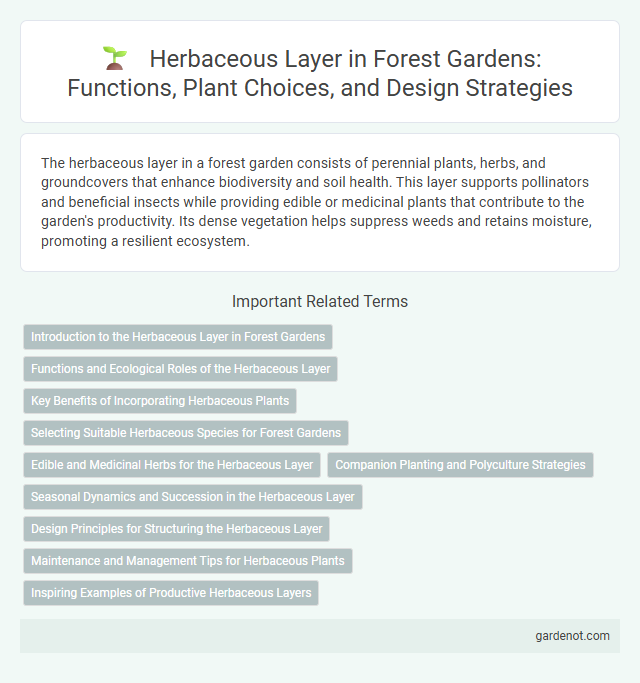The herbaceous layer in a forest garden consists of perennial plants, herbs, and groundcovers that enhance biodiversity and soil health. This layer supports pollinators and beneficial insects while providing edible or medicinal plants that contribute to the garden's productivity. Its dense vegetation helps suppress weeds and retains moisture, promoting a resilient ecosystem.
Introduction to the Herbaceous Layer in Forest Gardens
The herbaceous layer in forest gardens consists primarily of non-woody plants such as herbs, ferns, and wildflowers that thrive under the canopy. This layer plays a crucial role in enhancing biodiversity, improving soil health through nutrient cycling, and providing habitat for beneficial insects. Incorporating a diverse range of herbaceous species helps stabilize the ecosystem by supporting pollinators and suppressing weeds naturally.
Functions and Ecological Roles of the Herbaceous Layer
The herbaceous layer in a forest garden plays a critical role in nutrient cycling by decomposing organic matter and enriching the soil with essential minerals. It provides habitat and food sources for pollinators and beneficial insects, enhancing biodiversity and pest control. This layer also improves soil structure and moisture retention, supporting the growth of both trees and understory plants in the ecosystem.
Key Benefits of Incorporating Herbaceous Plants
Incorporating herbaceous plants in the forest garden boosts biodiversity by providing essential habitats for pollinators and beneficial insects. These plants improve soil health through nutrient cycling and organic matter contribution, enhancing overall fertility and structure. Their diverse root systems aid in erosion control and moisture retention, promoting a resilient and sustainable ecosystem.
Selecting Suitable Herbaceous Species for Forest Gardens
Selecting suitable herbaceous species for forest gardens involves prioritizing plants that thrive in understory environments, exhibit shade tolerance, and contribute to soil fertility through nitrogen fixation or organic matter accumulation. Perennial herbs like comfrey (Symphytum officinale), woodland strawberries (Fragaria vesca), and medicinal plants such as Echinacea purpurea are highly effective for enhancing biodiversity and providing yield within the herbaceous layer. Emphasizing native species adapted to local microclimates improves ecosystem resilience and supports pollinators, fostering a sustainable and productive forest garden ecosystem.
Edible and Medicinal Herbs for the Herbaceous Layer
The herbaceous layer in a forest garden comprises a diverse range of edible and medicinal herbs such as comfrey, mint, and yarrow, known for their nutrient-rich leaves and healing properties. These plants contribute to soil fertility, attract beneficial insects, and provide a sustainable source of fresh herbs for culinary and therapeutic use. Cultivating a variety of perennial herbs maximizes biodiversity while supporting ecosystem health and human wellness.
Companion Planting and Polyculture Strategies
The herbaceous layer in forest gardens utilizes companion planting and polyculture strategies to enhance nutrient cycling, pest control, and biodiversity. Combining nitrogen-fixing species with dynamic accumulator plants supports soil fertility while diverse herbs and ground covers suppress weeds and attract beneficial insects. Implementing layered plant guilds within this stratum optimizes spatial use and promotes resilient ecosystem functions.
Seasonal Dynamics and Succession in the Herbaceous Layer
The herbaceous layer in a forest garden exhibits distinct seasonal dynamics, with early spring ephemerals thriving under reduced canopy cover before the tree layers fully leaf out. Succession in this layer follows patterns of colonization, growth, and senescence influenced by light availability, soil moisture, and nutrient cycling, supporting biodiversity and soil health. Species composition shifts annually, promoting resilience and ecosystem stability through complementary interactions among perennial herbs, groundcovers, and nitrogen-fixing plants.
Design Principles for Structuring the Herbaceous Layer
Effective design principles for structuring the herbaceous layer in a forest garden emphasize plant diversity, spatial arrangement, and functional roles. Selecting native perennials with varying heights and root depths promotes soil health, moisture retention, and pest management. Integrating nitrogen-fixing species and pollinator-friendly plants enhances ecosystem resilience and productivity within the herbaceous stratum.
Maintenance and Management Tips for Herbaceous Plants
Regular pruning and mulching help maintain herbaceous layer health by promoting airflow and reducing weed competition in forest gardens. Monitoring soil moisture and applying organic compost enhance nutrient availability, ensuring vigorous growth of herbaceous plants. Seasonal removal of dead foliage prevents disease buildup, supporting sustainable management of the herbaceous layer.
Inspiring Examples of Productive Herbaceous Layers
The herbaceous layer in forest gardens features diverse perennial herbs such as comfrey, rhubarb, and mint, which enhance soil fertility and provide continuous harvests. Productive examples include guilds combining nutrient accumulators like comfrey with medicinal herbs like chamomile, maximizing yield and ecosystem health. Integrating dynamic accumulators and pollinator-friendly plants in this layer boosts nutrient cycling and supports beneficial insect populations.
Herbaceous layer Infographic

 gardenot.com
gardenot.com